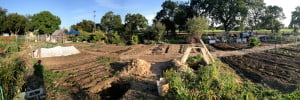
In the heart of Silicon Valley, less than two miles from the Stanford National Accelerator Laboratory (SLAC) and state-of-the-art computer science buildings, is the Stanford Farm. With irises, roses and lettuce all spilling into one another, the farm is totally insulated from the fast-paced, high-stress world that surrounds it (it doesn’t even have Wi-Fi), making it a campus rarity in more ways than one.
“It’s kind of ironic that people call Stanford ‘The Farm’ and this is as much of a farm as we have,” said Amanda Martinez ’14, head volunteer on the farm, the small, one-acre plot.
The farm is made up of two distinct parts: the Community Farm and the Educational Farm. The Community Farm is made up of small individual plots managed by professors, graduate students and other affiliates of the Stanford community.
The Community Farm was first chartered in 1996 when Brian Halweil ’97 requested a small plot of land near the golf course and equestrian center to be dedicated to giving students and community members a place to learn and practice agricultural methods. The Educational Farm is a small strip of land at the edge of the farm area — technically the Earth Systems Program’s plot on the Community Farm. The plot hosts melons, tomatoes, peas, beans, leafy greens, cucumbers and squash, as well as herbs and other plants.
“It’s really important for students…to have access to something like [the farm] where they can grow their own goods and meet other students who are also interested in food issues and where they can get dirty,” Martinez said.
Patrick Archie, a professor of earth systems who also holds the title of farm educator, agreed that it is important for students to engage in hands-on learning on the farm.
“The farm is a place where people can get experiential education that I think is the fundamental ingredient that ties everything together,” Archie said.
Archie currently teaches two classes, one in the winter called Food Matters, about representations of food and agriculture in film, and another called Practices and Principles of Sustainable Agriculture.
In the latter, according to Archie, students “learn the basics of everything that you need to do to take a little patch of earth and grow food for yourself<\p>.<\p>.<\p>.<\p>they also have the confidence to be able to understand at a fundamental level the ecological principles behind sustainable agriculture.”
There are six classes using the farm’s facilities this quarter, including a couple of student-initiated courses. Martinez co-teaches one of these courses, Grow it, Cook it, Eat It, with Jenny Rempel ’12, a Daily columnist. Martinez cites her own course as an excellent example of the strong relationship between the farm and Stanford Dining.
“Stanford Dining is completely in support of my class and the whole farm program out here,” Martinez said.
Cynthia Liu, administrative program manager of Stanford Dining, said in an email to The Daily that the Stanford Farm Project, a student group that supports farm initiatives, and the Stanford Educational Farm regularly work with Matt Rothe, the Stanford Dining sustainable food program manager, to help student groups interact more with Stanford Dining. Rothe also manages a plot of land on the Community Farm.
“I would say [Stanford Dining] is at the cutting edge of food movements among universities around the country,” Archie said. “They’ve really been thinking about meals that they serve as an educational opportunity.”
Although the farm does not currently have enough land to supply Stanford Dining with produce, Archie said they hope to be able to grow food that will be eaten in dining halls when they move to a new two-acre plot of land in about a year.
In addition to connections with student-initiated courses and Stanford Dining, the farm also has connections to classes in several disciplines. The devices on the farm that look like they’d be more at home in an engineering lab than on an organic farm are the product of classes such as Design and Construction for Sustainability in Extreme Environments, a class offered by the Civil Engineering Department that tests out products on the farm.
Among the projects being tested on the Educational Farm are pumps for low-cost irrigation for farmers in Myanmar, solar panels that electrify fences for farmers in India and underground seed storage techniques that could protect seeds in the case of a natural disaster.
Martinez added that in the past there have been groups making use of the farm from other engineering departments, the Graduate School of Business and the Hasso Plattner Institute of Design (d.school).
“No matter what they’re doing, whether they’re in graduate school or if they’re undergraduates, there’s just so many fields that connect to food and to farming that everybody can find something that interests them,” Archie said, commenting on the expansion of student involvement on the farm beyond the Earth Systems Program.
Leaders of the farm have noticed an increased level of community interest. In the past, the Community Farm has experienced problems with careless visitors trampling their plants, leading certain community members to be more wary of publicity. The Educational Farm, on the other hand, welcomes their increasing visibility.
“There are more and more food related groups popping up on campus, which is very promising for the Stanford food movement,” Martinez said.
She added that the Educational Farm had a few large groups of at least 50 Prospective Freshmen (ProFros) come tour the space over Admit Weekend.
“It was really great to have that much exposure with new students at the farm,” Martinez said.